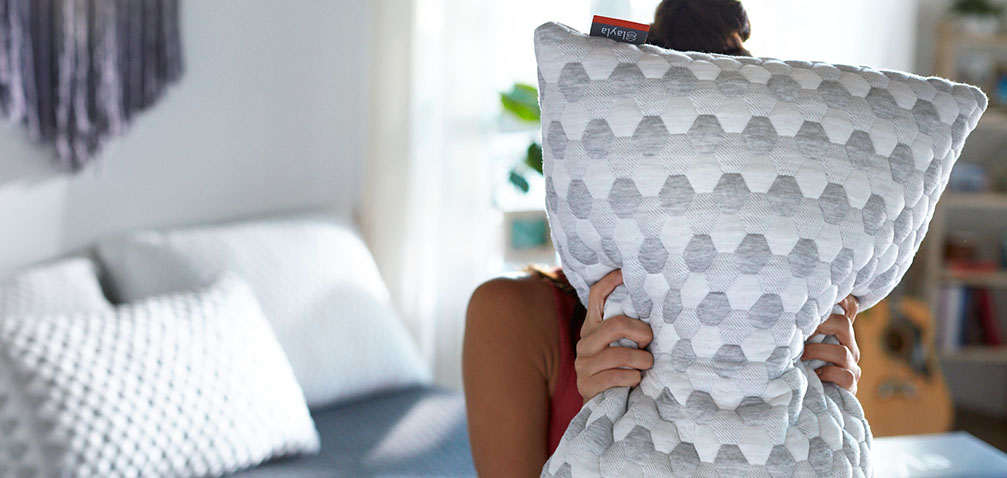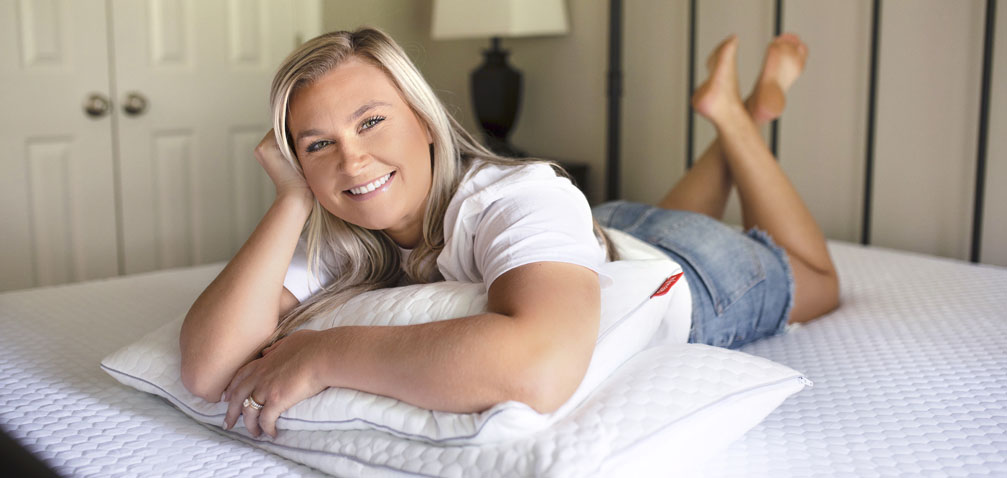- How Do You Fluff a Pillow By Hand?
- How Do You Fluff a Pillow in the Dryer?
- How Do You Fluff a Pillow By Air?
- What Are Signs You Should Fluff Your Pillow?
- When Should You Replace Your Pillow?
- Key Takeaways: How to Fluff a Pillow
How Do You Fluff a Pillow By Hand?
You’ve spent time and money to find the best pillow for sleeping — don’t let it go to waste. After learning how to buy the right bed pillow, you should know how to maintain them. Without the right support, you may experience neck pain and tossing and turning throughout the night. The best way to ensure your pillow can properly support your neck and head is to fluff it.
Of course, pillows don’t last forever, but fluffing can help them keep their shape. In addition to fluffing, you should learn how to wash pillows to remove any bacteria that can build up on them over time. However, you can fluff your pillow at any point, even if it hasn’t been recently washed. There are two popular methods for fluffing a pillow by hand:
Massage your pillow
Massaging is one of the easiest ways to fluff a pillow, and you can build it into your daily routine as part of making the bed. You don’t even have to take off the pillowcase or covering to do it. To fluff a pillow using the massage technique, follow these steps:
- Identify any lumps or bumps in the pillow
- Massage the lumps to break them up
- Fluff with another method to redistribute any lumps you’ve broken up
Accordion method
The accordion method is another popular method for fluffing a pillow with your hands. Again, you can do this with or without the pillowcase on. To fluff a pillow with the accordion method, follow these steps:
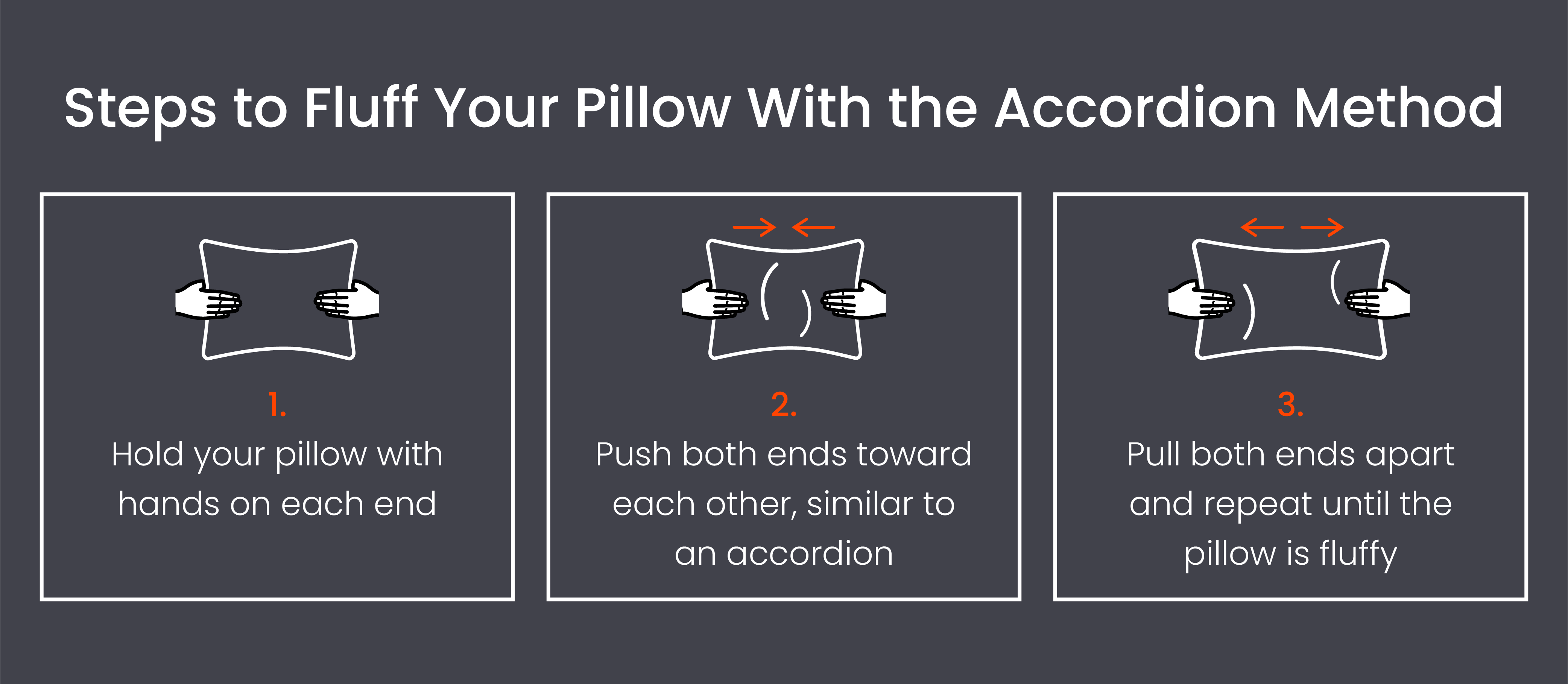
- Hold your pillow with hands on each end
- Push both ends toward each other, similar to an accordion
- Pull both ends apart and repeat until the pillow is fluffy
How Do You Fluff a Pillow in the Dryer?
Another way to fluff a pillow is by using the dryer. However, this option isn’t right for all pillows. If you fluff a pillow in the dryer and you’re not supposed to, your pillow could come out even lumpier than before, even though it will have more loft.
Manufacturer’s instructions
Before fluffing a pillow in the dryer, always read the manufacturer’s instructions to ensure it’s safe to put your pillow in the machine. Many manufacturers have specific cleaning instructions on the tags of their products and will provide you with steps for fluffing a pillow in the dryer if it’s possible and safe to do so. In most cases, if you can fluff a pillow in the dryer, you can place pillows on opposite sides of the machine.
Tennis ball method
The tennis ball method is one of the best ways to fluff a pillow in the dryer because the tennis ball will act as an agitator to massage the fibers and inner materials while ensuring the filling is evenly distributed. Here are the steps for fluffing a pillow in the dryer using the tennis ball method:
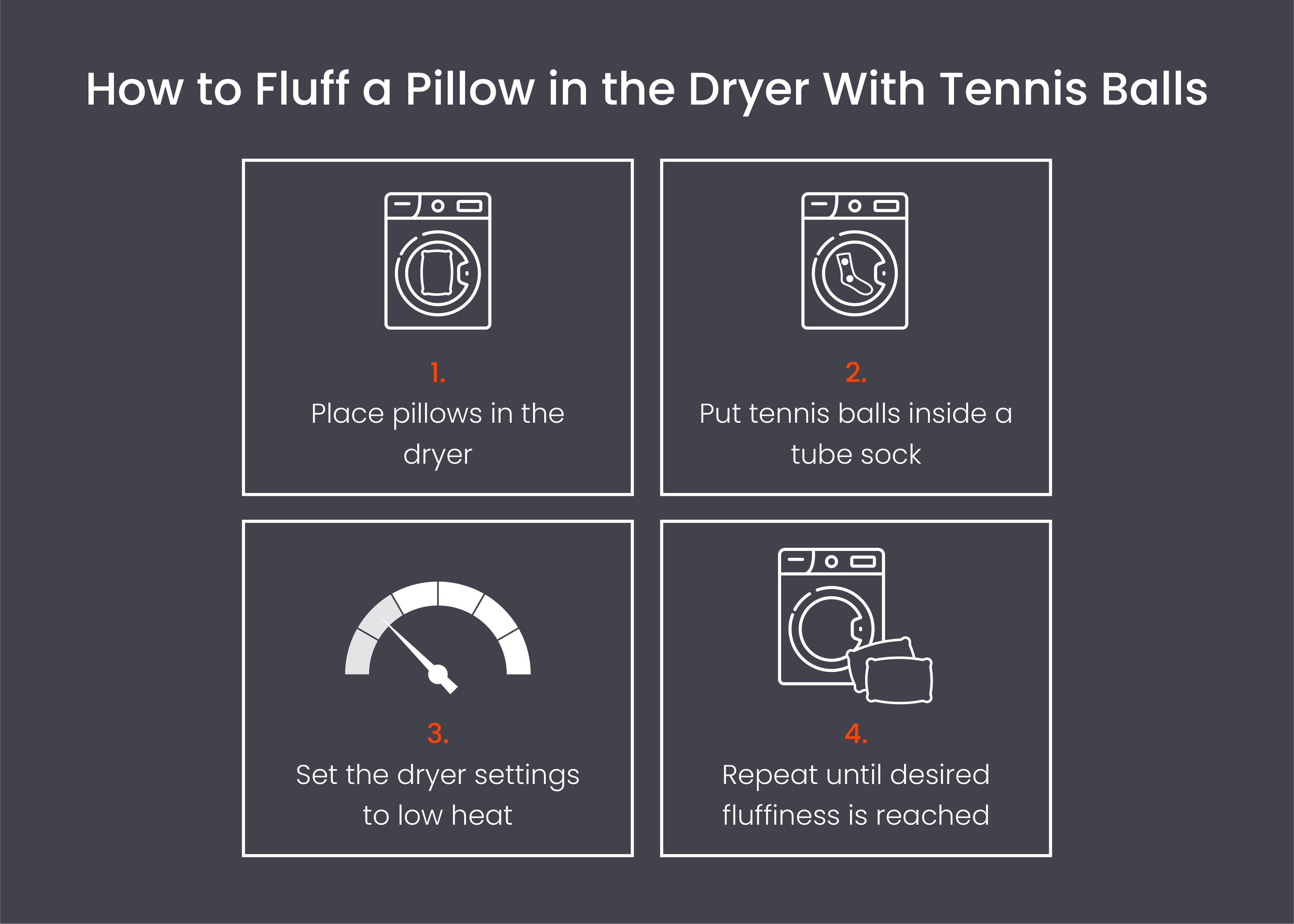
- Place pillows in the dryer: Consider fluffing two pillows at once to keep the machine balanced.
- Put tennis balls inside a tube sock: A tennis ball alone can be harsh on your machine, so it’s always best to put it in a tube sock or pillowcase.
- Set the dryer settings to low heat: Your dryer should be on the lowest heat setting to prevent burning or damage to the cover and filling.
- Repeat until desired fluffiness is reached: The tennis ball will fluff your pillow and break up any lumps and bumps. However, if your pillow has multiple lumps or the material has compacted, it may take a few cycles before it feels like itself again.
How Do You Fluff a Pillow By Air?
Fluffing a pillow requires some pressure or force, which is why the tennis ball method and massage are effective. If you have a lumpy pillow, you’ll need something to break up the lumps. However, air can also be used to fluff a pillow that’s not too far gone.
Hang dry your pillow
After washing your pillow, consider avoiding the dryer altogether and air drying it outside in the sunlight instead. The sun can kill bacteria and naturally fluff your pillow, and they’re easy to hang on a regular clothesline. Of course, this method is not enough to break up compacted lumps, so you may have to try another method first. Still, air-drying your pillow can be healthier for you, especially if you’re worried about bacteria or mold.
What Are Signs You Should Fluff Your Pillow?
Unfortunately, many people don’t fluff their sleeping pillows because they think they’ll last forever. While no pillow lasts forever, fluffing a pillow can extend its lifespan to ensure you have the best pillow. Wondering if your pillow needs to be fluffed? Here are a few clear signs:
- Neck or shoulder pain: Waking up with neck pain may mean you’re using the wrong pillow or your pillow has changed. Your pillow is meant to help you fall asleep faster and stay asleep by supporting your neck and head. However, if you’re experiencing neck and shoulder pain, it may mean your pillow has lost some of its loft and needs to be fluffed to break up any lumps or bumps.
- Headaches: Improper support of the head and neck can cause tension headaches. If your pillow is too high or low, your neck can easily roll around the pillow, straining the muscles in the neck and head, so if you’re experiencing headaches after sleeping, your pillow might need to be fluffed.
- Fails the fold test: If your pillow folds in half and doesn’t immediately return to its normal position, it must be fluffed. Your pillow should never be able to remain folded. If it does, it means there’s some level of material compression that can prevent you from getting a good night’s sleep.
- Tingling in your arms or fingers: Tingling in the arms and fingers can occur when your neck and shoulders are out of alignment because it cuts off circulation. If your arms are asleep in the morning and you haven’t slept on them, it may be because of your pillow.
When Should You Replace Your Pillow?
As we’ve mentioned numerous times, pillows aren’t immortal. While you might have a favorite pillow for sleep, your pillows should be replaced every one to two years, depending on the manufacturer’s recommendations. Other telltale signs you should replace your pillow include:
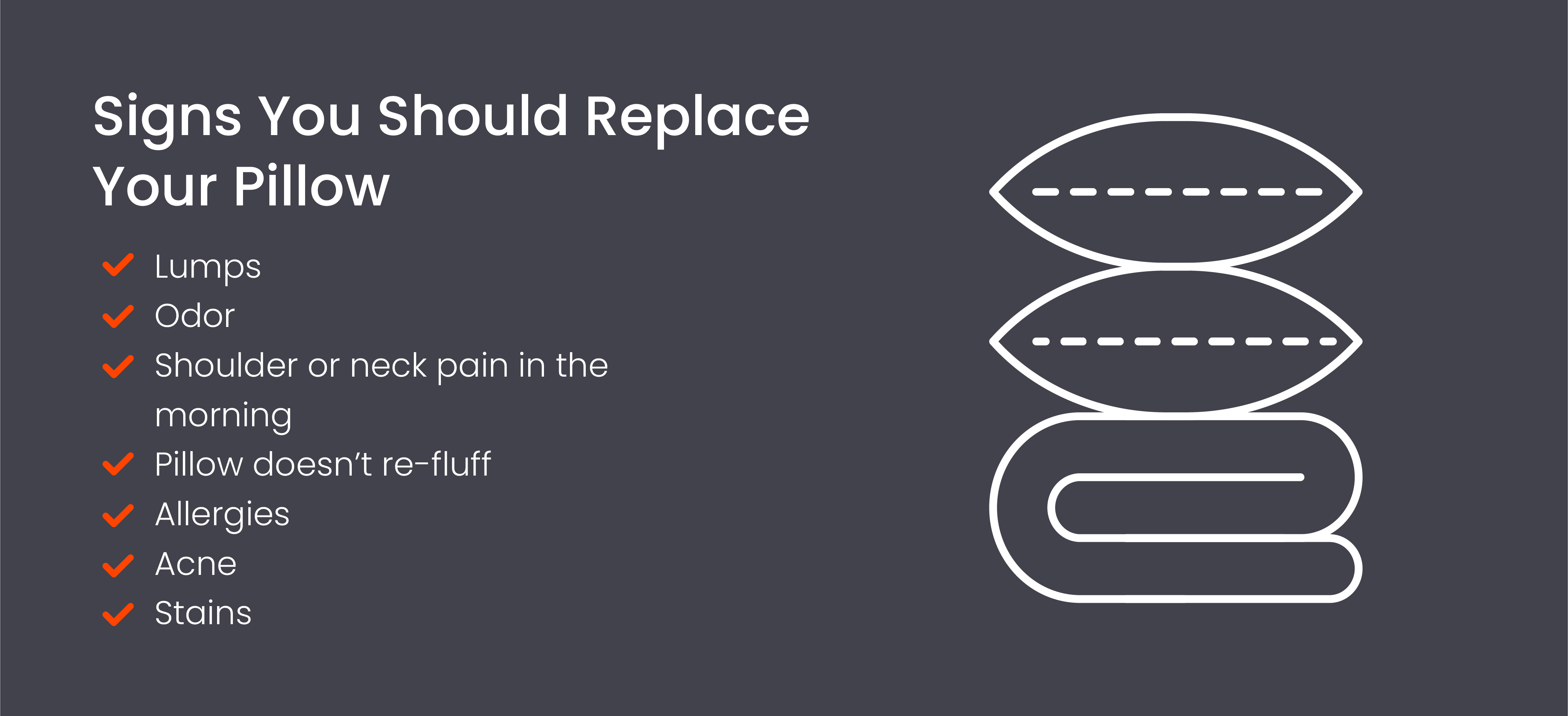
- Lumps: Lumps mean your pillow has gone long enough without being fluffed that the inner material has started to compact. These lumps can be uncomfortable and put your neck and head in an uncomfortable position while you sleep, resulting in pain when you wake up.
- Odor: When you sleep, your body sheds bacteria, skin oils, and sweat that can seep into your pillow even if you have an antimicrobial pillowcase. A healthy pillow shouldn’t smell, so if there’s a foul odor coming from your pillow, it means it’s time to replace it. Washing your pillow won’t be effective enough to remove this potentially dangerous allergen if your pillow smells like mold.
- Shoulder or neck pain in the morning: If you experience shoulder or neck pain in the morning, even after fluffing your pillow, you might not have the right pillow for your body or sleeping position. For example, stomach sleepers need a flatter pillow than side sleepers, so you should always consider your sleeping position when choosing the best pillow for you.
- Pillow doesn’t re-fluff: If your pillow doesn’t re-fluff, and you’ve tried every technique we’ve listed here, it’s time for a new one. At this point, your pillow’s inner materials have compacted too much to be re-fluffed, and you’ve lost loft, which might contribute to neck and shoulder pain.
- Allergies: If you experience allergies only at night and in the bedroom, it might be because of your pillow. Unfortunately, dust loves pillows, and sleeping on a pillow that contains dust is enough to exacerbate allergy symptoms.
- Acne: If you have acne, you may need to replace your pillow more often. In addition, if you can’t seem to get rid of acne or have been experiencing it a lot more lately, it might be because of your pillow. Even with a great pillowcase, your pillow absorbs moisture and oils from your body that can clog your pores, so using the same pillow every night for years means re-introducing those oils to your skin.
- Stains: If your pillow has more than a few stains from drool or natural body oils, consider what’s going on inside the pillow. Of course, some stains on your pillow are normal, but an excessive amount means your pillow has collected too much oil and bacteria from your body, which isn’t healthy for you to sleep on.
Key Takeaways: How to Fluff a Pillow
Fluffing your pillows can improve sleep quality by ensuring they have the proper fluff and loft to support your head, neck, and spine. Unfortunately, pillow fluffing can become compressed or compacted over time, and if you don’t fluff it, you may lose some of the firmness that makes your pillow so comfortable. Luckily, fluffing a pillow is easy, but you should replace it every one to two years, especially if it becomes seriously compressed or smells.
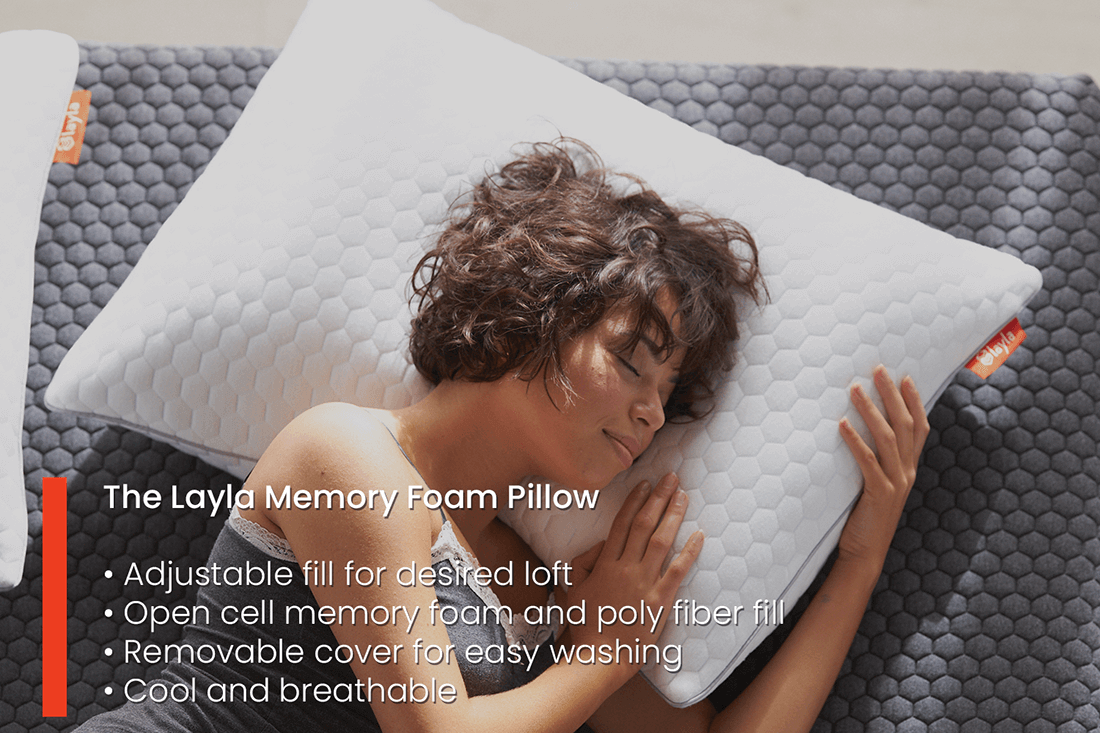
Looking for your next favorite pillow? Browse Layla’s selection of Kapok Pillows and Memory Foam Pillows that are soft, supportive, and cooling.

